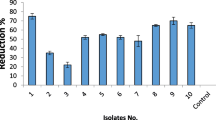Abstract
Damping-off of tomato caused by Rhizoctonia solani was controlled in a pot test using the biological agent, Bacillus subtilis RB14-C, and the chemical pesticide, Flutolanil. The co-utilization of B. subtilis RB14-C, and Flutolanil decreased the amount of Flutolanil used from 375 μg/pot when Flutolanil was used alone to 94 μg/pot, while exerting the same effect of reducing disease occurrence.
Similar content being viewed by others
References
Asaka O, Shoda M (1996) Biocontrol of Rhizoctonia solani damping-off of tomato with Bacillus subtilis RB14. Appl. Environ. Microbiol. 62: 4081–4085.
Cook RJ (1990) Twenty-five years of progress towards biological control. In: Hornby D, ed. Biological Control of Soil-Borne Plant Pathogens Wallingford, UK: CAB International, pp. 1–14.
Gutterson N (1990) Microbial fungicides: recent approaches to elucidating mechanisms. Crit. Rev. Biotechnol. 10: 69–91.
Hiraoka H, Asaka O, Ano T, Shoda M (1992a) Characterization of Bacillus subtilis RB14, coproducer of peptide antibiotics iturin A and surfactin. J. Gen. Appl. Microbiol. 38: 635–640.
Hiraoka H, Ano T, ShodaM(1992b) Molecular cloning of a gene responsible for the biosynthesis of the lipopeptide antibiotics iturin and surfactin. J. Ferment. Bioeng. 74: 323–328.
Huang C-C, Ano T, Shoda M (1993) Nucleotide sequence and characteristics of a gene, lpa-14 responsible for the biosynthesis of the lipopeptide antibiotics iturin A and surfactin from Bacillus subtilis RB14. J. Ferment. Bioeng. 76: 445–450.
Hwang SF (1994) Potential for integrated biological and chemical control of seedling rot and preemer-gence damping off caused by Fusarium avenaceumn in lentil with Bacillus subtilis and Vitaflo-280. Z. Pflanzenkr. Pflanzenschutz. 101: 188–199.
Hwang SF, Chang KF, Howard RJ, Deneka BA, Turnbull GD (1996) Decrease in incidence of Pythium damping-off of field pea by seed treatment with Bacillus spp. and metalaxyl. J. Plant Dis. Prot. 103: 31–41.
Mandeel Q (1996) Integration of biological and chemical control of Fusarium wilt of radish. J. Plant Dis. Prot. 103: 610–619.
Phae CG, Shoda M, Kita N, Nakano M, Ushiyama K (1992) Biological control of crown and root rot and bacterial wilt of tomato by Bacillus subtilis NB22. Ann. Phytopath. Soc. Japan 58: 329–339.
Shoda M (2000) Bacterial control of plant diseases. J. Biosci. Bioeng. 89: 515–521.
Weller DM (1988) Biological control of soilborne plant pathogens in the rhizosphere with bacteria. Annu. Rev. Phytopathol. 26: 379–407.
Author information
Authors and Affiliations
Rights and permissions
About this article
Cite this article
Kondoh, M., Hirai, M. & Shoda, M. Co-utilization of Bacillus subtilis and Flutolanil in controlling damping-off of tomato caused by Rhizoctonia solani. Biotechnology Letters 22, 1693–1697 (2000). https://doi.org/10.1023/A:1005675829479
Issue Date:
DOI: https://doi.org/10.1023/A:1005675829479




